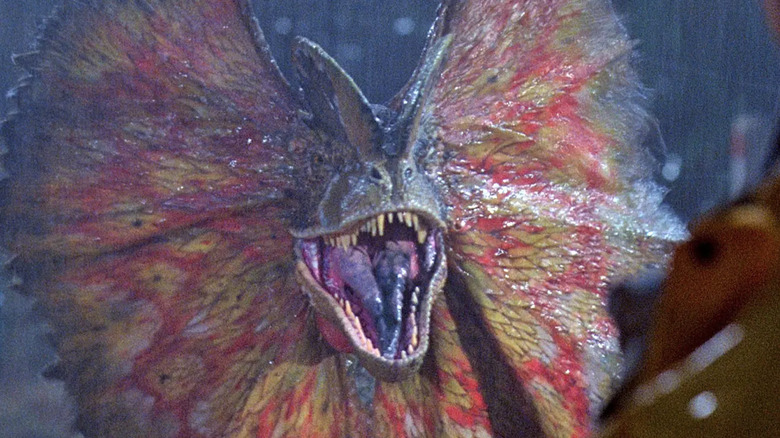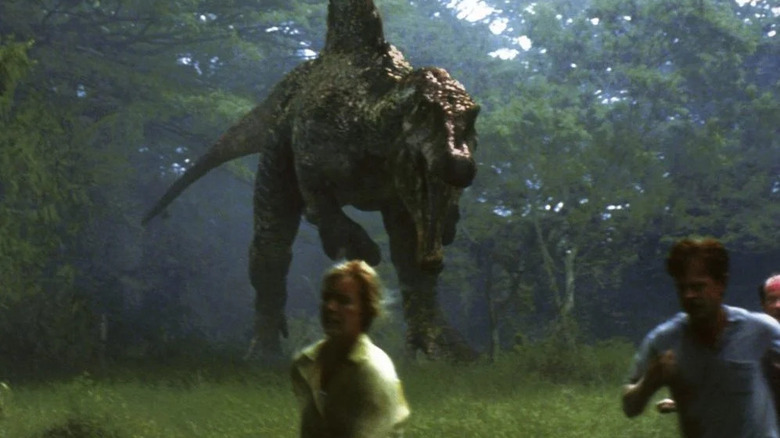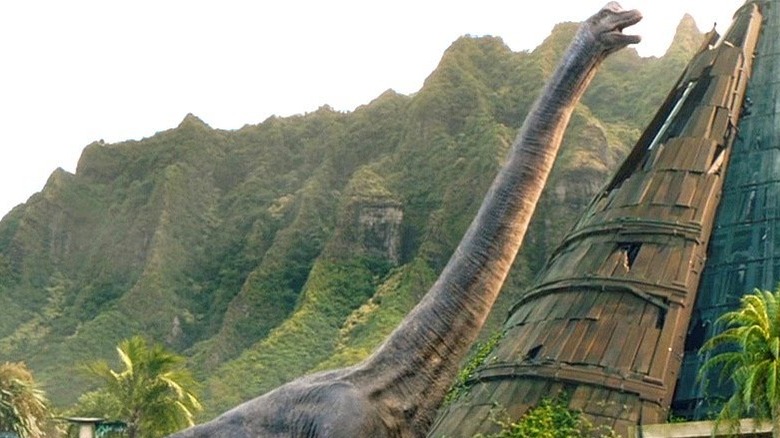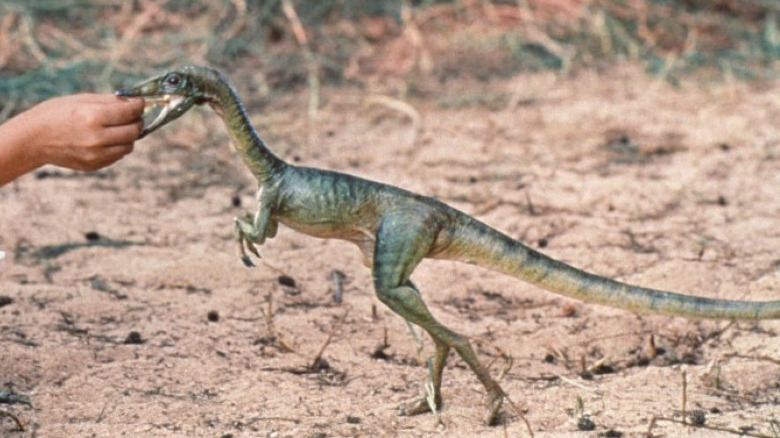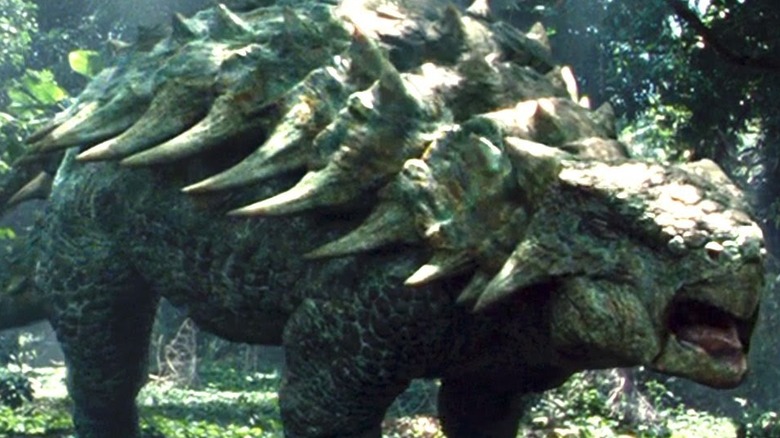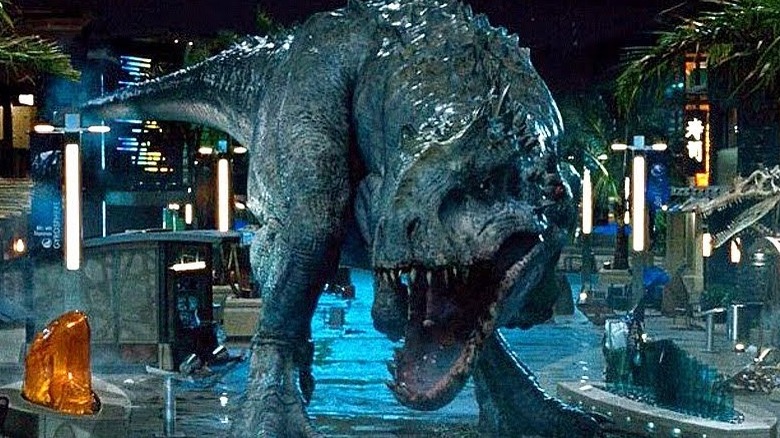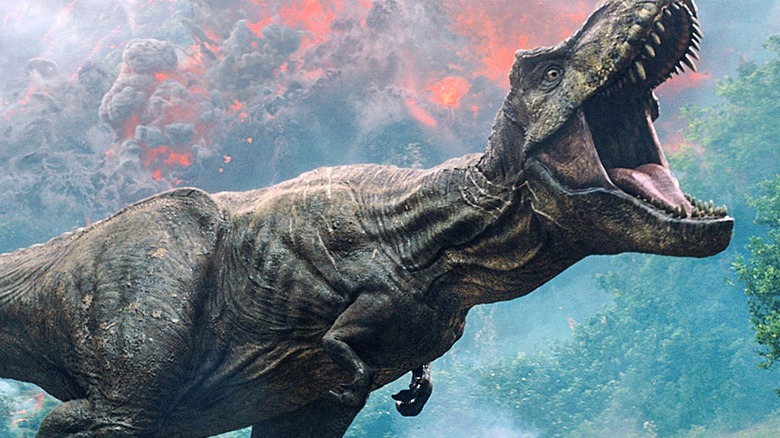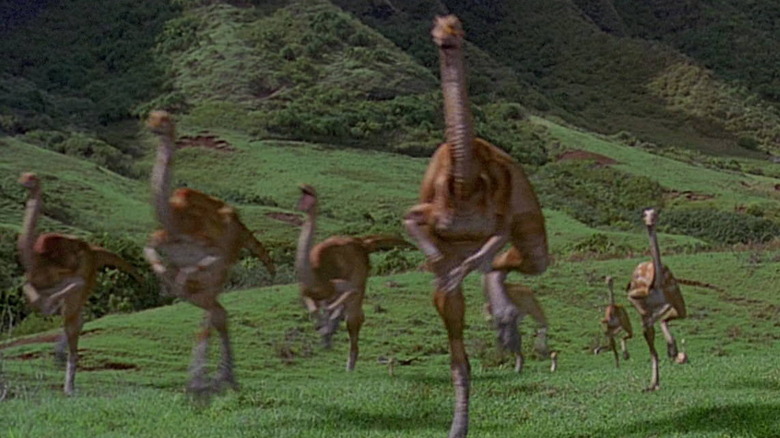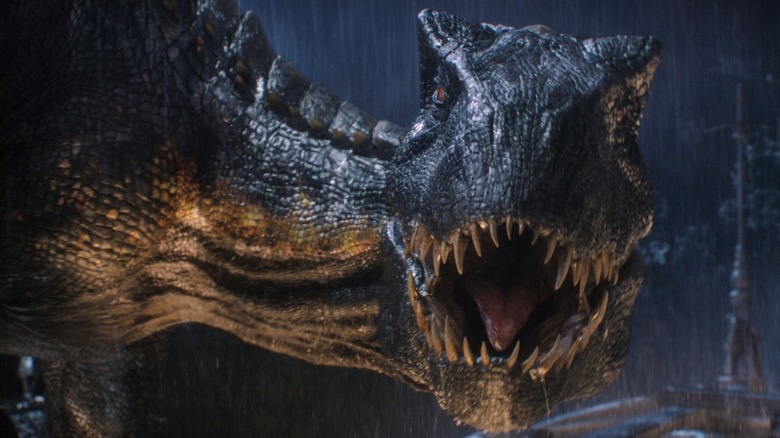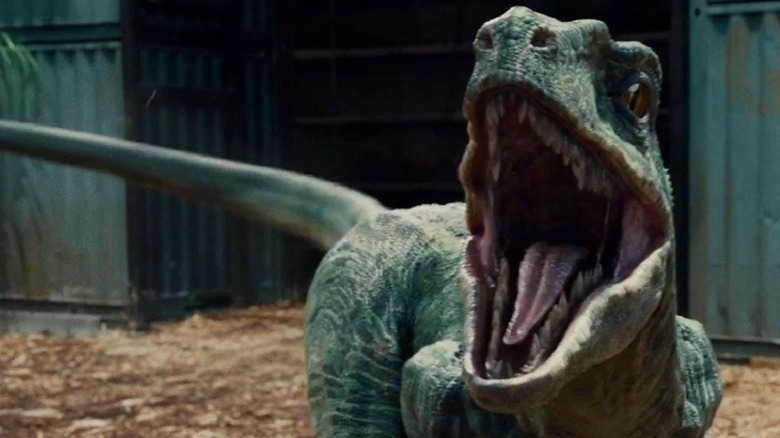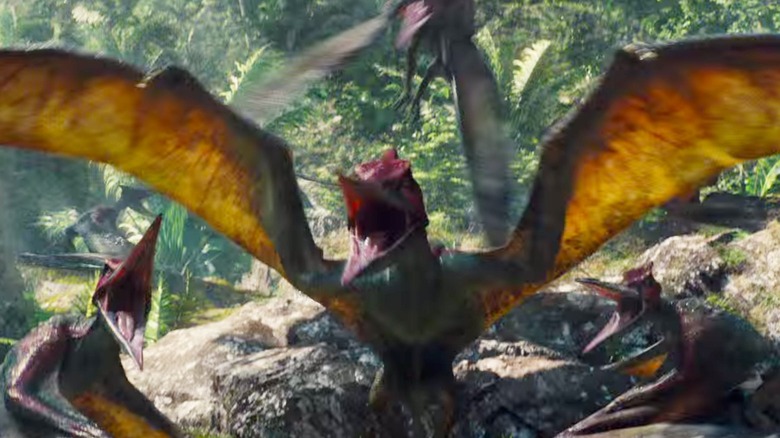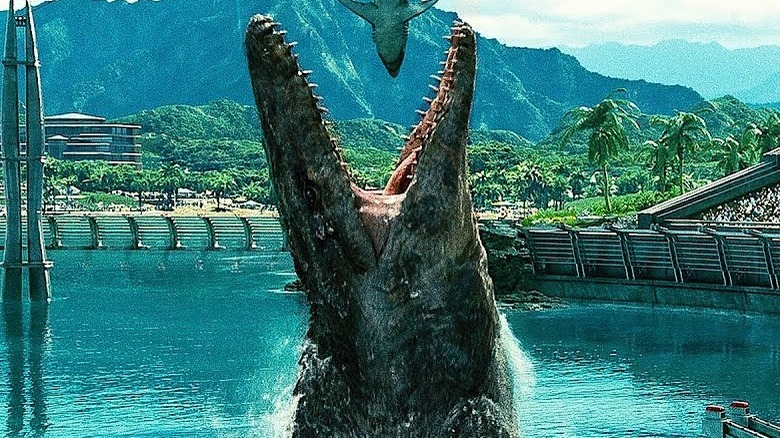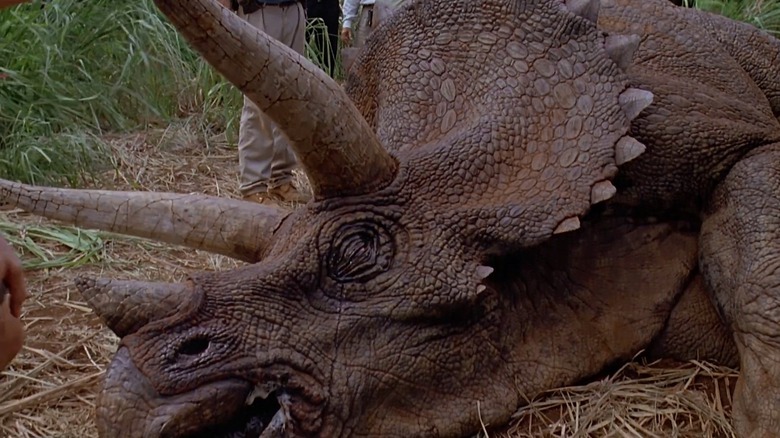The Jurassic Park Dinosaur You Are Based On Your Zodiac Sign
The "Jurassic Park" franchise is, perhaps, the most iconic dinosaur-related slice of pop culture to ever be produced. Based on the book of the same name by Michael Crichton, Steven Spielberg's 1993 early-CGI masterpiece became such a phenomenon that pressure from the public (and Spielberg) caused Crichton to write his first-ever sequel. "The Lost World" yielded 1997's "The Lost World: Jurassic Park," and at this point the series has become a two-book, six-film, one-animated show franchise that continues to spawn other properties and even includes at least one character based on a real paleontologist.
Between the original "Jurassic Park" trilogy and newer "Jurassic World" trilogy, there have been over thirty dinosaurs, some real and some not, depicted across the franchise. While audiences may remember dinosaurs like the Triceratops and Tyrannosaurus rex from school, the franchise introduced them to Dilophosaurus and Parasaurolophus, even fictionalizing new dinosaurs like the Indominus rex and the Indoraptor.
Although these dinosaurs aren't talking (yet), the films give them plenty of personality. Then there are the signs of the zodiac, which break down specific personality traits and attribute them to your date of birth. With that in mind, here's a fun breakdown of which "Jurassic" dinosaurs correspond to which astrology signs. Are you as terrifying as the T-Rex, bold as the Dilophosaurus or nimble as the Gallimimus? Read on to find out and please, for your own safety — remain inside your vehicle at all times.
Aries (March 21—April 19): Spinosaurus
The Spinosaurus feels like it could be a classic Aries. In the franchise, they're bold and adventurous, top dinosaur on the island in 2001's "Jurassic Park 3." Though this is the only film in the franchise a living Spinosaurus appears in, it clearly shows an aggressive, energetic personality — qualities found in an Aries in abundance.
In "Jurassic Park 3," the Spinosaurus has no qualms showing it is a leader among dinosaurs on Isla Sorna. It goes after the group of human characters, and even fights and kills a Tyrannosaurus rex. It takes courage and ambition to take on a T-Rex, and the Spinosaurus does it with ease, killing the T-Rex and solidifying the Spinosaurus's place as the head dinosaur. We even find out the species is attracted to the scent of T-Rex urine, meaning they want to know where their opponent is at all times so they can remain at the top of the food chain.
Scenes like this establish that the Spinosaurus is a strong leader but also has the ability to quickly move on, like an Aries. The Spinosaurus pivots quickly from the humans to tearing the T-Rex apart. Like most folks with an Aries sign, it is an excellent multi-tasker.
Taurus (April 20—May 20): Brachiosaurus
The Brachiosaurus sure seems like a Taurus. Gentle and dependable, they are depicted as calm, resilient, and practical, all key Taurus traits. They are also one of the most consistent in terms of appearances across the franchise, even through graphic depictions in the parks, meaning audiences can almost always depend on a Brachiosaurus to make an appearance.
When audiences were first introduced to this dinosaur in the original "Jurassic Park," it was calm, gentle, and made no effort to attack or show any signs of aggression toward Dr. Grant (Sam Neill) and Dr. Sattler (Laura Dern). Its desired effect was to drive home the sense of beauty and wonder in seeing a dinosaur returned to life and, well, mission accomplished.
The doctors were able to get pretty close to the Brachiosaurus, as the dinosaur just continued about its day, nibbling away at the leaves in the trees. When Dr. Grant, Tim (Joseph Mazzello), and Lex (Ariana Richards) have an even closer encounter with a Brachiosaurus later on in the film, the dinosaur continues to be gentle and harmless. In "Jurassic World: Fallen Kingdom," a Brachiosaurus walks right by Owen (Chris Pratt), Claire (Bryce Dallas Howard), and the others that are trying to rescue the dinosaurs before the volcano erupts. They act just like the dinosaur from "Jurassic Park," being calm and continuing about their day, eating leaves from a tree. However, audiences also see the resilience of the dinosaur. They run like the rest, trying to make it to the boat in time, resulting in one of the saddest scenes in the franchise to date.
Gemini: Compsognathus (May 21—June 21)
Geminis are curious and often have two sides to their personality. The dinosaur that best represents that is the Compsognathus. These dinosaurs are one of the smallest, if not the smallest, dinosaurs featured in the franchise, and many people mistake them for the "cute" ones. As seen throughout the franchise, they look adorable and harmless — until you get close.
In "The Lost World: Jurassic Park," a young girl vacationing on Isla Sorna encounters a single Compsognathus, feeds it, and then as she calls her parents to come and see what she found, more of the little dinosaurs appear. Even though she throws the sandwich for them, thinking that's what they want, it is her they go after. The individual Compsognathus was curious about her, but also determining if she was a potential meal.
In "Jurassic World: Fallen Kingdom," they're shown eating someone after the dinosaurs are set free, though they were not responsible for killing them. Even before being transported off the island, a Compsognathus is shown in one of the abandoned souvenir shops. At first, it looks like one of the models that were once for sale, and then it moves. Their scenes in "Fallen Kingdom" reinforce the narrative presented in "The Lost World," that these dinosaurs have two sides to their personality, just like a Gemini.
Cancer (June 22—July 22): Ankylosaurus
Cancers are represented by the crab, so what better dinosaur to represent them than the one with a literal hard outer shell? The Ankylosaurus keeps to itself, trying not to engage in situations they stumble into. However, like Cancers, this dinosaur can come across as temperamental because of how quickly it can shift its attitude. The "Jurassic Park" franchise has depicted both of these sides of the Ankylosaurus in the films.
In "Jurassic Park III," a group of these dinosaurs pass the tourists on two different occasions, and during both encounters, they keep to themselves. The Ankylosaurus sees no reason to start a confrontation and chooses to protect itself and recharge rather than create an altercation, acting much like a Cancer would. This is different from the Ankylosaurus audiences encounter later on.
In "Jurassic World," some Ankylosauruses notice the Indominus rex and try to flee, sensing the danger of the situation and choosing to protect themselves. However, once one falls, the dinosaurs immediately shift from terrified to angry, trying to fight the Indominus rex coming after them. While both situations show different behavior from the Ankylosaurus, they are consistent with the temperamental and self-protective nature of a Cancer.
Leo (July 23—August 22): Indominus rex
Introduced in "Jurassic World," the Indominus rex is one for theatrics. Leos are dramatic and creative, as is the Indominus rex.
To escape their enclosure, these dinosaurs fake evidence that they climbed over the wall of their enclosure, cloaking their thermal signature (big shout-out to Dr. Henry Wu for adding in that tree frog DNA) and getting the guards to open the gate. As guards and Owen Grady investigate the enclosure, they realize what's happening when the control room says the tracking implant shows the dinosaur in there with them. Then it becomes a mad dash to get out and close the gate, but they're too late. The Indominus rex's plan was as creative as it gets.
Leos are confident in themselves, and the Indominus rex embodies that. This zodiac sign usually wants to stand out from the crowd, and that's something the Indominus rex was created to do. They were designed to be the most terrifying dinosaur of all time, which certainly makes them stand out from the other dinosaurs at the park, past and present.
Virgo (August 23—September 22): Tyrannosaurus rex
Virgos are known for being observant and analytical. The Tyrannosaurus rex is one of the most, if not the most, hyper-aware of all the dinosaurs. They carefully take in their surroundings as they hunt for prey, looking for the smallest change in movement to indicate something, or someone, is nearby. As soon as they see movement, they attack, not wasting the opportunity, but don't take that to mean the T-Rex is impulsive. Their careful observance is to their benefit because of their eyesight. Without it, they could miss their next meal.
While it may not seem this way, the T-Rex is a very grounded and order-regulating dinosaur in the franchise, just like Virgos are in the world. In "Jurassic World," it's the T-Rex that restores order on the island after the Indominus rex causes chaos. When using the Velociraptors to bring down the Indominus rex backfires, and it seems the team won't be able to defeat the Indominus rex, it is the T-Rex who saves the day.
In attacking the Indominus rex, the T-Rex insured the island could continue to be evacuated and people moved to safety. They also ensured other dinosaur species (including themselves) could continue to live on the island with a normal food chain, because the Indominus rex was not designed to ever be a part of that ecosystem.
Libra (September 22—October 23): Gallimimus
The Gallimimus is the definition of balance, which is an important trait for Libras. Their name means "chicken or fowl mimic," and it's not hard to see why they were given it. They look like the true balance between reptiles and flightless birds, similar to ostriches or emus. Dr. Grant even compares them to birds when he encounters them. Like Libras, the Gallimimus tends to be most comfortable in groups (or herds in this case); accordingly, it's rare to see one of these dinosaurs on their own.
In "Jurassic Park," the Gallimimus run through the fields to get away from the Tyrannosaurus rex, trying to get away from the conflict, just like a Libra would. Though avoiding conflict, it's clear these dinosaurs are great communicators. As Dr. Grant says, they have "uniform direction changes" as they're running from the T-Rex, shifting their direction of movement as if they all shared one brain. Even the baby Gallimimus moves at the same speed and in the same direction as the adults.
When audiences saw these dinosaurs again in "Jurassic World," they were once again moving in a similar fashion, staying together in a group and using vocalizations to communicate while circling a tour vehicle, reinforcing that the Gallimimus is the Libra of the dinosaur world.
Scorpio (October 23—November 21): Indoraptor
The Indoraptor is one of the newest dinosaurs in the franchise, and very clearly the dinosaur that best represents Scorpios. Designed as a hybrid of Velociraptors and the Indominus rex (which is already a hybrid), the Indoraptor acquired traits from both, including their cunning nature and ability to dominate in social situations. This dinosaur has only been featured in "Jurassic World: Fallen Kingdom" so far, but in that appearance audiences saw just how calculating and ingenious the hybrid could be as they channel their inner Virgo.
In "Fallen Kingdom," the Indoraptor fakes their sedation in the havoc that ensues after the dinosaur auction, convincing mercenary Ken Wheatley (Ted Levine) that they have been subdued by the tranquilizer darts he used on them. When Ken gets close, trying to get a tooth as a souvenir, the Indoraptor pounces and kills him. This is a Virgo trait through and through, utilizing their mind to navigate the situation like a game, coming out as winner.
Unlike the Spinosaurus, the Indoraptor is set on attacking Owen (all because someone pointed a laser sight at him), unrelenting in their pursuit, even when Blue the Velociraptor continues to attack. This unrelenting pursuit, a common Virgo trait, leads to the dinosaur's downfall, as Blue continues to come at them, with both falling through the glass ceiling. While Blue survives, the Indoraptor is killed after being impaled on the mounted skull of another dinosaur.
Sagittarius (November 22—December 21): Velociraptor
The Sagittarius sign is known for its curiosity, as well as a constant pursuit of knowledge of the world around them. Velociraptors are the dinosaurs that display similar qualities. One of three dinosaurs to appear in all six films, there are numerous situations and examples of the Velociraptor being a Sagittarius, showing their curiosity, intelligence, and loyalty.
In "Jurassic Park," they had to switch how they fed the Velociraptors because they were "testing the [electric] fences for weaknesses systematically," showing just how intelligent and curious about the world these dinosaurs can be. It's implied that if they found a weaker portion of the fence, they would focus their efforts on it as a means of escape.
In "Jurassic World," Owen had been able to "train" the Velociraptors, but only to the point that they acknowledge him as their alpha. This is later put to the test by the Indominus rex, who successfully changes their allegiance to themself. Like a Sagittarius, the Velociraptors sought new ideas and relationships, though it didn't last long. Owen is able to regain alpha status with the Velociraptors, ultimately showing their loyalty to the original alpha.
Sagittariuses are incredibly loyal, and that loyalty is seen again in "Jurassic World: Fallen Kingdom." In that film, Blue remembers who Owen is when she encounters him again on the island, even protecting him from the Indoraptor after the dinosaur auction. Her loyalty to him was present throughout the film, showing another reason why Velociraptors are the ideal dinosaur representation of a Sagittarius.
Capricorn (December 22—January 19): Pteranodon
Capricorns are resilient and go after what they want in life. That accurately describes the Pteranodons we see in the franchise. Like Capricorns, they're patient, sometimes stubborn, and work hard for what they desire.
In "Jurassic Park III," when the group is in the aviary, the Pteranodons know they are there. But, they don't attack right away. They wait as the humans cross the bridge, landing in front of someone just before they start to cross. That takes patience to plan and wait for the right opportunity. It isn't necessarily a surprise, though, because these dinosaurs have always gone after anything they wanted in the films, showing that Capricorn tenacity.
In "Jurassic World," after being freed from the aviary, they proceed to attack the hoards of people congregated in Jurassic World's main space. In what is arguably a scene that went too far, Zara, Claire's assistant, is carried away by a Pteranodon. Even when they drop her, another Pteranodon grabs her again. When dropped for a second time, this time into the Mosasaurus enclosure, the dinosaurs dive into the water after her. While this can be seen as going after what they want, it also is them being stubborn, a common label for Capricorns. There were plenty of other moving things they could've gone for, but they continually went for the same one, even if it resulted in being eaten by the Mosasaurus.
Aquarius (January 20–February 18): Mosasaurus
The Aquarius sign tends to be different from the group, an individual in the masses. That's exactly what the Mosasaurus of "Jurassic World" is. This dinosaur is independent and unafraid to try something new when the time comes, just like an Aquarius.
In "Jurassic World," the Mosasaurus is alone in its environment, but that's only because there is no one else like it. Like an Aquarius, the Mosasaurus is open to exploring the world outside its tank, but does not need another Mosasaurus around to do it. While they could be described as solitary, this dinosaur is better described as independent.
At the end of "Jurassic World," one came on land to drag the Indominus rex into their tank, presumably as a meal. The dinosaur could've done that at any time while thousands of humans were in front of them. They made the choice when they wanted to. In "Jurassic World: Fallen Kingdom," when the opportunity presented itself to leave the only body of water they had ever known, the Mosasaurus took it, just like an Aquarius still trying to understand the world around them.
Pisces (February 19—March 20): Triceratops
Pisces are emotional, intuitive, and very strong, which also describes the Triceratops in "Jurassic Park." The Triceratops depicted throughout the franchise so far have shown a wide range of emotions while also displaying a gentle nature that can turn sour when overwhelmed.
In "Jurassic Park," Drs. Grant and Sattler find a sick Triceratops. The dinosaur they encounter is one of the most emotionally expressive seen in the franchise, making them seem like a strong Pisces. Even though the Triceratops is sick, the range of emotions playing out across its face is evident. It also shows how emotionally sensitive the Triceratops is, which is an important characteristic of a Pisces. Even when they're caged in "The Lost World: Jurassic Park," and it is obvious how upset the dinosaur is to be confined, they only react negatively to the situation when they're overwhelmed.
In "Jurassic World," baby Triceratops are used in the petting zoo, presumably due to their gentle nature. In "Jurassic World: Fallen Kingdom," the same expressive emotions from "Jurassic Park" are seen again as an adult Triceratops tries to comfort a baby one while they are locked away during the dinosaur auction. The expressive nature of the Triceratops sure makes them feel like a true Pisces.
